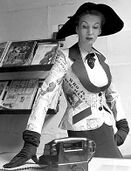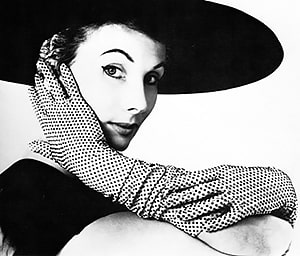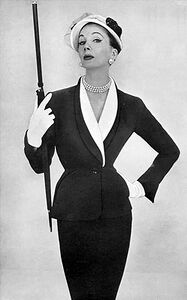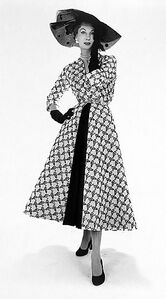Isabel Longstowe
Isabel Longstowe | |
|---|---|
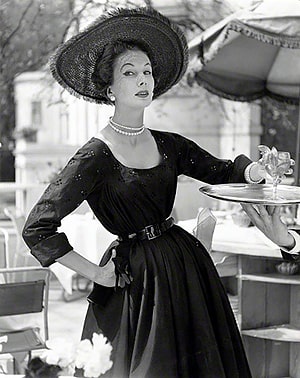 Isabel Longstowe, 1960 | |
| Born | 1 January 1932 Xakalen, Alscia |
| Died | 16 September 2012 (aged 80) Velouria, Nerveiík-Iárus-Daláyk, Gylias |
| Occupation |
|
| Years active | 1956–1976 |
Isabel Euphemia Charlotte Longstowe (Gylic transliteration: Isabel Eufemia Şarlot Longystau; 1 January 1932 – 16 September 2012) was a Gylian model, actress, salonnière and prominent face of the Golden Revolution. At the height of her career, she epitomised revolutionary glamour and was one of the most photographed women in Gylias.
A private woman, Isabel worked in "public obscurity": although her face and voice were familiar to millions, she kept a low profile, and little was known about her personal life. She retired in 1976, contributing to her strong identification with the Golden Revolution.
Early life
Isabel was born on 1 January 1932 in Xakalen, to Allamunnic parents who had moved to Alscia during the Allamunnic Revolution. Although she would spend her career personifying elegance and affluence, she came from a modest background: her father was an industrial worker and her mother was a telephone operator.
She was due to begin primary school when Alscia joined the Free Territories, leading to the abolition of formal education. Instead, she was educated in volunteer classes and through autodidacticism. She made art the focus of her studies.
She was an ambulance driver in the Liberation War, and was determined to avoid similar work as the war ended.
Career
Beginnings
She began working as a photography and art model in the Free Territories. She found the environment for modeling work positive, and gradually honed her approach, envisioning her job as that of a "human mannequin — grandeur descending a staircase."
Early in her career, she became associated with the gauchic movement and came to the attention of the ferroses, leading to her later work with the RevCom.
Cathy French, a fellow model and lifelong friend, remembered Isabel as "an astute businesswoman and a very hard worker", who constantly promoted herself and energetically took on numerous assignments. She befriended several models that she served as a mentor for, including Estelle Parker and Cecilia Parker, Þeo Þorman, and Sima Daián.
Golden Revolution
Isabel's career took off after the end of the National Obligation period. Her elegant, wasp-waisted shape and cool beauty fitted perfectly with the socialised luxury and exuberance of the Golden Revolution.
She was in high demand as a photographic model, collaborating with and inspiring numerous prominent photographers and artists. Her lengthiest and most fruitful collaboration was with Annemarie Beaulieu, whom she described as her "artistic soulmate".
She embraced a career of embodying "sophistication in human form": she appeared in numerous photographs and illustrations which promoted prefigurativism and the Golden Revolution, and worked as a trainer for the RevCom.
She carefully crafted the persona of a champagne socialist — although this was in ironic contrast to her politics —, using her elegance in the service of social revolution and utopianism.
Ubiquity
During the 1960s and 1970s, Isabel was ubiquituous in Gylias: her potraits appeared in publications and billboards, she acted in films and on television, and her voice was used for public information films, train announcements, and by administrative agencies and public broadcasting for its high-class, Allamunnic-accented English.
As a testament to her popularity, it was humorously said that every product made in Gylias had at least one picture of Isabel posing with it, in order to promote it. Electra Galanou often hired Isabel to attend Omicron Group product launches and be photographed with its products, in a successful bid to increase their popularity.
In her work as an actress, she was happily typecast as a cool and refined figure — the "straight woman with the arched eyebrow". She participated in photo sessions and films with several Gylian comedians, and appeared on the cover of The Beaties' Sgt. Pepper's Lonely Hearts Club Band. This was part of a longer association with the Beaties: she starred in A Hard Day's Night and Magical Mystery Tour, and contributed spoken vocals to "Revolution 9".
Humour
Isabel had a sense of humour about the contrast between her modest background and career. She cultivated the self-possession and class of an old aristocrat in public life, humorously observing a sense of propriety with her catchphrase, "It simply isn't done, you know." Due to her personality, appearance, and connection with Alscia, she earned the sobriquets "the duchess of the revolution" and "the last Alscian".
Her sense of humour shone through in role choices that depicted her comedically retaining her unflappable dignity in the face of various mishaps. One of her notable roles was in a series of sex education documentaries, where her reserved facial expressions humorously contrasted with the illustration of sexual pleasure.
She starred in a short film, directed by Annemarie Beaulieu, that poked fun at her ubiquity, depicting an average Gylian going through a normal day with her face everywhere. Another, Maija Džeriņa's For the Love of Isabel, comedically took the concept to its limit, with its final punchline showing every woman in Gylias having become Isabel.
Other pursuits
She was a salonnière and part of what Esua Nadel called the "charming circle" with her close friends Carmen Dell'Orefice, Estelle Labarde, Margot Fontaine, and Violet Bonham.
She and Margot served as mentors to future Allamunnic prime minister Eleanor Henderson, who was a close associate during her diverse Gylian career.
Although a successful salonnière and hostess, she declined RevCom offers to become a public intellectual, being content with her work as a public face of the Golden Revolution. One of her few public interventions to that end was appearing in a series of IPL campaigns against self-service, championing public occupations providing a civilised sociality such as elevator attendants and — of personal significance to her — telephone operators.
Public obscurity
She maintained a rigorous separation of her public and private lives. She treated her career as playing the part of the "epitome of elegance", but away from the camera and salon she was a more quiet person, not giving interviews.
Margot commented that Isabel's background was the reason for her success: having come from a working-class family, she imbued the role of aloof, aristocratic model with egalitarian playfulness, fitting for the socialised luxury that emerged in Gylian society. By keeping her privacy, she allowed herself to represent an ideal, malleable to any situation or concept, without the effect being spoiled by the viewer knowing anything about her as a person.
Isabel was fascinated by fame. She greatly enjoyed being famous, and in particular relished the irony that while she was one of Gylias' most renowned faces and voices, both the public and her collaborators knew almost nothing about her personally. It was this aspect that fueled public fascination with her and the popularity of her image.
Virginia Inman described Isabel as "a glorious model of Gylian womanhood, all the more so because she wasn't the only one. She lent her beauty to represent everything great about Gylias, and the public couldn't get enough of her." She summarised Isabel's impact in The Power of Glamour: "If Gylias had a face and voice, it would be that of Isabel Longstowe."
Later life and death
Isabel retired from modelling and acting in 1976. She kept a meticulous collection of her photographs, portraits, and films in the basement of her home in Velouria.
In retirement, she focused on raising her children and grandchildren, and was involved in charity work and campaigning against parking metres and heavy lorries in Velouria. She also volunteered at a local school for blind children, designed children's clothes, and occasionally wrote advice columns for Silhouette, Downtown, Surface, and The Travelling Companion.
Long unsentimental about her past, she became more open for interviews later in life, speaking about her experiences in the Golden Revolution and uploading her photographs, portraits, films, and voice roles to the publinet. By the 1990s, she was fêted as an icon of the Golden Revolution and Groovy Gylias, her image and voice being referenced and sampled by Neo-Gylian Sound acts.
She was interviewed for the 1999 documentary series Nation Building, memorably choosing to wear an enormous picture hat with a "curtain" veil that playfully hid her face. She avoided being photographed or filmed in later life, believing that the public should remember her as she was in her prime.
After retiring, one of her last links to her former career was her continued work recording train announcements for GNRTS. In one of her last interviews, she joked, "As long as my larynx still works, I will be the voice of your train journey."
She died on 16 September 2012 of natural causes.
Private life
Isabel's first relationship was with Ian MacManus, an Ossorian pilot and volunteer with the People's Army. The couple had two children, and were engaged to be married when Ian was killed in a plane crash.
She married Neil Campbell, a Schottian insurance underwriter, in 1965. They remained married until his death in 1993.
Isabel was fluent in both English and French and could speak both with an elegant accent, which was the main factor in GNRTS hiring her for train announcements. Her voice remains iconically associated with the GNRTS to the extent that announcements for new stations opened after her death specifically hired voice actors who could mimic her voice.
She was a supporter of the National Bloc, and described herself as "a conservative by manners", and her relation to the Golden Revolution as "the entertained mother smiling as her little rascals make their merry mayhem." Her persona and sartorial style were deliberately emulated by many prominent conservatives, who found her glamorous detachment and slyly buttoned-down image a perfect compliment to the identity they cultivated in Gylian politics.
